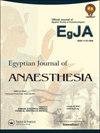Perfusion index as a predictor of hypotension after induction of general anesthesia in elderly patients – a prospective observational study
IF 0.5
Q3 ANESTHESIOLOGY
引用次数: 0
Abstract
ABSTRACT Introduction The elderly patients are at a greater risk for hypotension after induction of anesthesia. Perfusion index (PI) predicted patients vascular responses in many situations. This study hypothesized that baseline value of PI would predict hypotension in geriatric patients after anesthetic induction as population at risk for postinduction hypotension. Methods This observational, prospective study involved 30 patients aged >65 years who were scheduled for elective procedures under general anesthesia. From baseline to 15 min after propofol induction of anesthesia, the PI, heart rate, and blood pressure (BP) were recorded every minute. Hypotension was defined as a decrease greater than 30% in systolic BP from baseline. Results Early hypotension within 3 min after induction was experienced in 53.3%, while 36.7% had late hypotension within 15 min. Receiver operating characteristic (ROC) curves for PI as a predictive test of hypotension at 3 min showed good predictability of the baseline PI for early postinduction hypotension with area under receiver operating characteristic curve (AUC) 0.97, sensitivity 88%, specificity 93%, positive predictive value (PPV) 93%, negative predictive value (NPV) 87%, and a cutoff value of ≤1.3. After intubation, the predictive value decreased, with PI > 0.91 to predict late hypotension with sensitivity 91%, specificity 58%, PPV 56%, NPV 92%, and AUC 0.66. Conclusions PI could predict early hypotension following propofol induction in the geriatric population. So, it can be considered a valuable tool in monitoring this vulnerable population after induction of anesthesia.灌注指数作为老年患者全麻诱导后低血压的预测指标——一项前瞻性观察研究
本文章由计算机程序翻译,如有差异,请以英文原文为准。
求助全文
约1分钟内获得全文
求助全文
来源期刊

Egyptian Journal of Anaesthesia
Medicine-Anesthesiology and Pain Medicine
CiteScore
0.90
自引率
0.00%
发文量
78
 求助内容:
求助内容: 应助结果提醒方式:
应助结果提醒方式:


